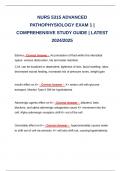NURS 5315 ADVANCED
PATHOPHYSIOLOGY EXAM 1 |
COMPREHENSIVE STUDY GUIDE | LATEST
2024/2025
Edema - Correct Answer - Accumulation of fluid within the interstitial
space- venous obstruction, Na and water retention
C.M. can be localized or dependent, tightness of skin, facial swelling, rales,
decreased wound healing, increased risk of pressure sores, weight gain
insulin effect on K+ - Correct Answer - K+ enters cell with glucose
transport. Monitor Type II DM for hypokalemia
Adrenergic agents effect on K+ - Correct Answer - albuterol, beta
blockers, and alpha adrenergic antagonists cause K+ movement into the
cell. Alpha adrenergic receptors shift K+ out of the cell
Osmolality effect on K+ - Correct Answer - hyperosmolality causes water
to shift out of cell via osmosis. K+ will also shift out, causing hyperkalemia.
,Cell lysis effect on K+ - Correct Answer - intracellular K+ is released into
bloodstream
Exercise effect on K+ - Correct Answer - cellular ATP is diminished,
opening K+ channels and allowing K+ to leave cell
Kidneys effect on K+ - Correct Answer - excretion and absorption of K+ is
regulated by tubule system
magnesium and potassium - Correct Answer - mag inhibits the potassium
channels, keeping balance. when mag is low, more K+ exits the call, and is
excreted via the kidneys.
metabolic acidosis - Correct Answer - E. increased acid production, loss
of bicarb, diminished renal excretion of hydrogen
C.M hyperventilation (compensatory), h/a, n/v/d, dehydration, hypotension
pH <7.4 HCO3 <22
metabolic alkalosis - Correct Answer - E. GI loss, diuretic use
C.M. slow, shallow respirations, irritability, twitching, s/s of hypokalemia
pH >7.4 HCO3 >26
,respiratory acidosis - Correct Answer - E. cns depression, airway
abnormalities
C.M. restless, confused, seizures, tachycardia
pH <7.4 PaCO2 >44
respiratory alkalosis - Correct Answer - E. usually anxiety, PE, chf,
salicylate OD, illegal drugs
C.M. light-headed, confused, tetany
pH >7.4 PaCO2 <38
Allele - Correct Answer - Paired genes on autosomal chromosomes
Phenotype - Correct Answer - Outward appearance of an individual
Genotype - Correct Answer - A map of ones specific genes
Polymorphic - Correct Answer - Two or more alleles which occur with an
appreciable frequency in a population
Homozygous - Correct Answer - Two dominant or recessive alleles
, Heterozygous - Correct Answer - When both a dominant and a recessive
allele are present
Dominant - Correct Answer - Trait seen in phenotype
Recessive - Correct Answer - Trait not seen in phenotype
Autosomal chromosomes - Correct Answer - first 22 of 23 chromosomes
sex-linked chromosomes - Correct Answer - 23rd pair of chromosomes
Hypertrophy - Correct Answer - E. Increase in cell size
P. Caused by hormonal stimulation or increased functional demand, which
increased the cellular protein in the plasma membrane, endoplasmic
reticulum, myofilaments, and mitochondria (not cellular fluid)
Physiologic: skeletal muscle hypertrophy for persons doing heavy
work/weight lifting. one kidney removed, the other kidney increases in size
to accommodate for workload
Pathologic: cardiomegaly from HTN/L ventricular hypertrophy
Hypoxic Injury




